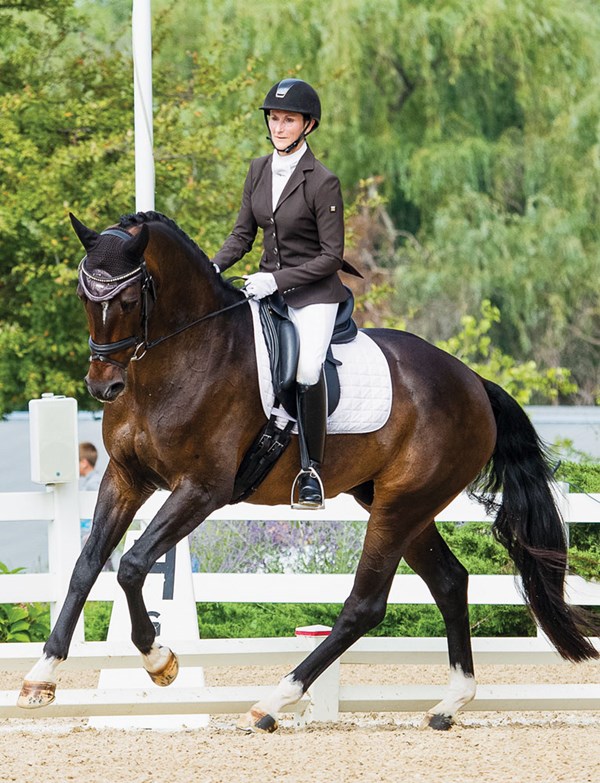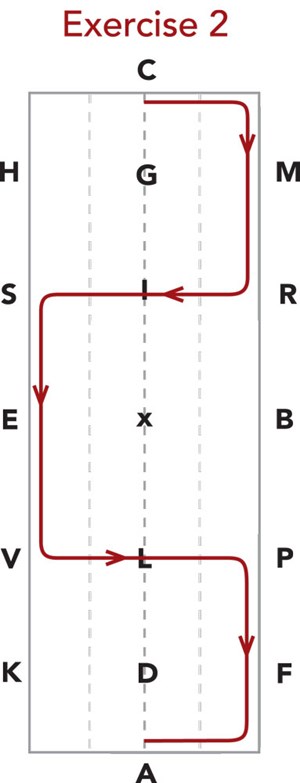In my early teaching years, I learned that along with the natural aids (the leg, seat and rein aids), the British Horse Society acknowledges the thought aids.
The late Swedish trainer Anders Lindgren, coached instructors to pause the work and explain the process and goals of each exercise to the students so they would clearly understand the desired end result.

When I teach, I try to be sure my students understand the results we are aiming for. This helps them put intention into their aids. They keep their eye on the prize and can promptly soften when they achieve it. Having a clear intention eliminates some of the delay and allows riders to more fully understand the training as it unfolds. Engaging their intention gives them more immediate and long-term influence.
Improve Clarity
Clarity of intention includes the expectation of the horse’s specific response to an aid. I’d like to draw upon comments from two previous contributors to this column: Volker Brommann (October 2015) said that once the horse learns to give the rider a correct basic response to an aid, the horse can develop readiness so that the rider can get the same result promptly from softer aids. I think we can do that only when we develop a level of physical and mental readiness in ourselves, which requires what Jeremy Steinberg (September 2015) called the “library-quiet position.” With a quiet position, your horse can hear every intentional aid and adjustment and you can hear every response.
Before we can talk about aids, we need vocabulary that explains dosage and function: Active aids are meant to produce a specific response from and change in the horse. Regulating aids are intended to prevent, limit or regulate the speed of changes to the horse’s current situation. Passive aids are in contact with and attentively follow the horse’s barrel, back and mouth passively. They monitor or listen to the horse.
Aids can further be categorized into primary aids and modifiers. Primary aids are like the verbs of our language. Modifying aids are like the adverbs. For example, the primary aid says, “move over,” and the modifier says, “straightly.” “Move over straightly” means “leg yield.” There can be more than one modifier, but we must communicate and produce the primary result before we can modify it. The delay between the two may be miniscule, but there must be a delay at least in the early training. If there is confusion, we first address the response to the primary aid and then we can address the modifiers.
The appropriate and timely release of the active aids is an important part of clear communication, helping the horse to understand that he responded correctly. This release of aids is also a key factor in improving a horse’s attention and readiness for the next aids.
A Word about Release
“Release” doesn’t usually mean to give all of the aids away. Rather, it refers to the release of active aids down to the level of passive or regulating aids. The “library-quiet position” that Jeremy Steinberg described has a great deal of tone in it so the rider remains stable on a moving horse. That stable position provides a framework for the horse to maintain his good form, and the tone in the position indicates to the horse that he is to remain at attention and ready for the next aids. Inexperienced riders often release the active aid and also release their tone and regulating aids. As a result, the intended reward ends up being a collapse of support. Then they have to start all over again to repeat the good response.
Exercise 1: Applying Your Intention
Clarity of intention improves the clarity of the aids. I often ask my students to talk as they ride—to think out loud. This can be hard at first. When the student first begins talking about what is in her head, I often hear whole sentences and paragraphs that include too much information: “I’m working on throughness and bend….”
I then ask the student to tell me what she is thinking in one word that can be supported by a clear, simple aid: “Go…There…Over…Straight…Good!…Easy…Swing!” You can do this on your own with your horse. Periods of silence are fine, but your position must be silent as well.
Next, notice your horse’s response as you say the word and apply the aid. This step ties your intention to your aid along with an expectation of an immediate response. The key is to get a noticeable response from your horse in one stride or beat. If not, a little “uh-oh” alarm sounds, and your aids may need to be stronger or quicker. Of course, you don’t want to use strong aids all the time, but an occasional firm or quick, clear aid is less offensive than prolonged, ineffective aids.
When your intention, your aids and your horse’s response are united, you will see that your circles become rounder, your lengthenings more balanced and your transitions more prompt. Your horse will be more on the aids with less wandering and noise in the body language. Smaller aids gain more influence faster.
Your one-word approach becomes rhythmic because the moment of actively applying the aid and feeling the result happens within one stride or even one beat. There is no time for essays in your head or negative thinking about your riding abilities.
This mental and physical agility occurs in the moment and is akin to meditation. It is one of the most important qualities required to perform at a high level in dressage where you need to assess and make changes promptly without getting hectic.
Exercise 2: The Rectangular Serpentine
Preparing for and riding corners and turns in the correct bend and then straightening within one stride is your goal. The rectangular serpentine is a good exercise for this challenge. Think positively! Ride this as you did in Exercise 1—use one-word directives: “Turn…Straighten…Listen…Flex…Bend…Turn…Straighten…Wait…Turn.” The directive is followed by a simple aid and then the expectation of a result.
1. Begin tracking right from C in trot.
2. Ride the corner before M as a quarter of a 10-meter circle.
3. Before R say, “Turn,” and ride a 90-degree turn to the right as another 10-meter quarter circle, so you’re facing S.
4. After the turn, say the word “Straighten” and use your outside straightening aids: Level your seat bones so your horse is completely straight by the quarterline. Focus on keeping the horse straight between the corridor of the aids, making the outside of your horse shorter to match the inside of your horse. Then push him into your new outside (right) rein.
5. At the next quarterline before S, say “Flex” and flex your horse left in one stride. Your horse will be ready for the in-the-moment aids to bend in the new direction. Then bend through your next 10-meter turn.
6. Finish your serpentine using the R–S–V–P letters in the same manner. This is difficult because the directives come in rapid succession.
The exercise may lead to a few messy moments, but with this challenge, rider and horse will be more on their toes and begin to sort out the aids to improve clarity and effectiveness.

Rachel Saavedra is a Grand Prix trainer and instructor based in Livermore, California. She has been on the USDF instructor certification faculty for more than 18 years, teaching workshops for trainers around the country. She is a popular national and international clinician for amateurs and professionals alike.











